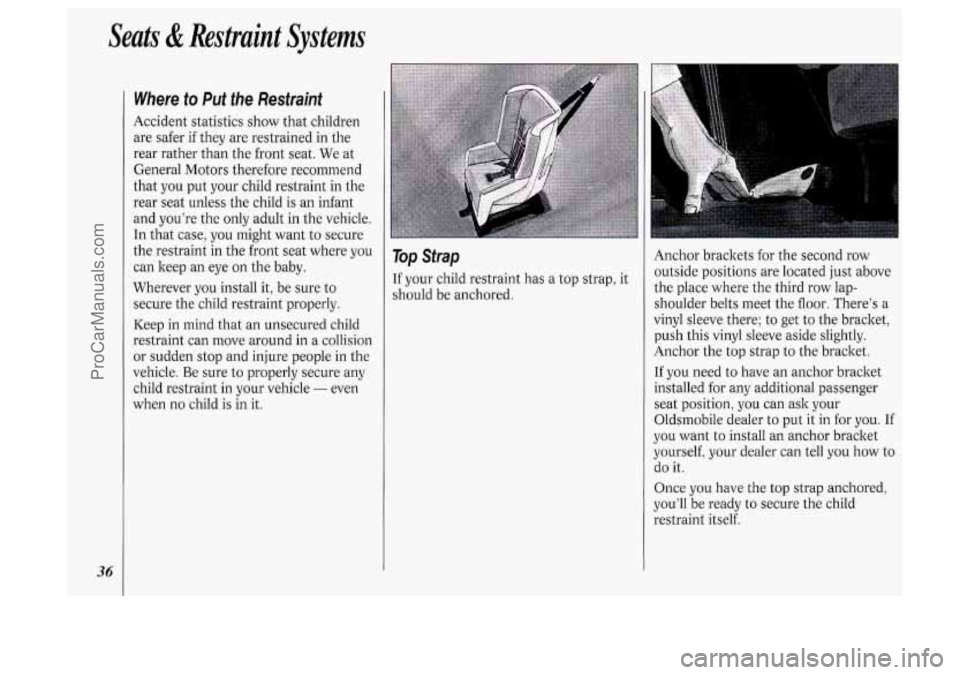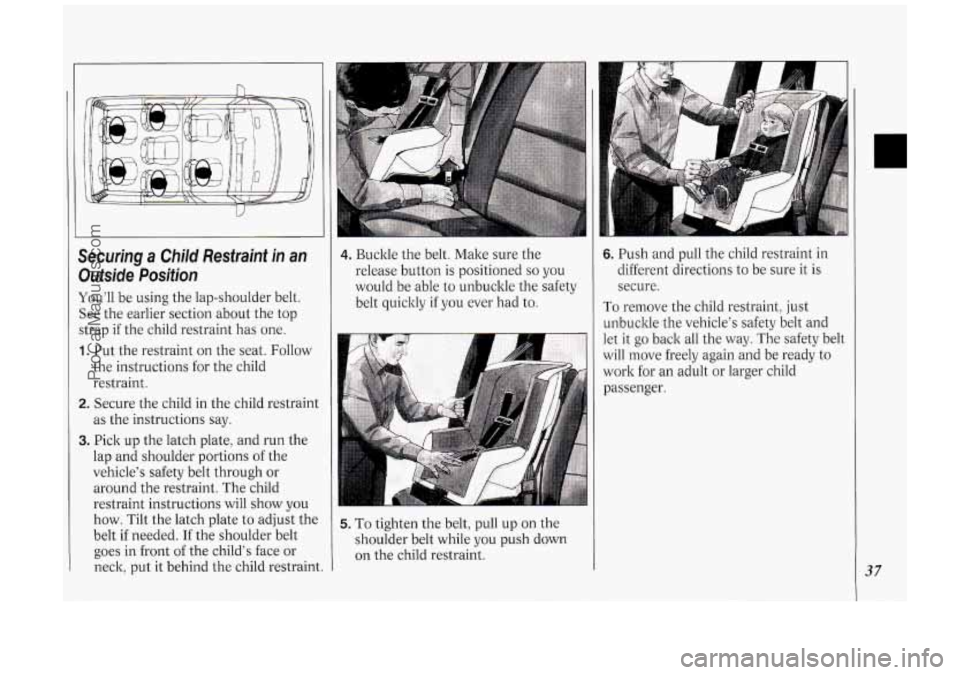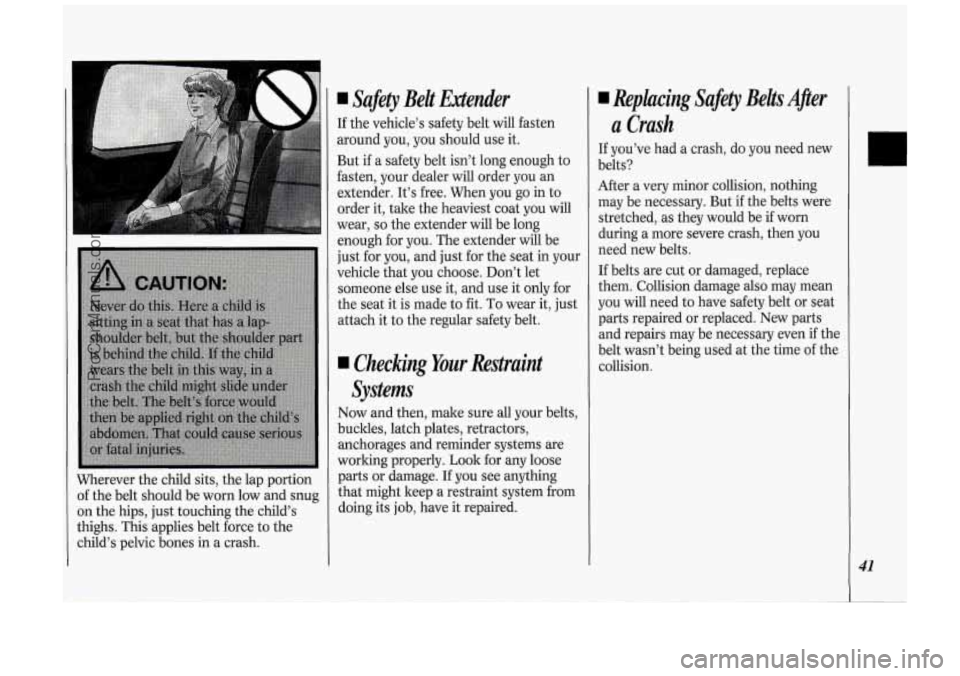Page 35 of 276
3. To make the lap part tight, pull down
on the buckle end of the belt as you
pull up on the shoulder part. The lap part of the
belt should be worn
low and snug on the hips, just touching
the thighs. In a crash, this applies force
to the strong pelvic bones. And you’d bc
less likely to slide under the lap belt. If
you slid under it, the belt would apply
force at your abdomen. This could
cause serious or even fatal injuries. The
shoulder belt should go over the
shoulder and across the chest. These
parts of the body are best able to tale
belt restraining forces.
The safety belt locks
if there’s a sudden
stop or a crash.
33
ProCarManuals.com
Page 37 of 276
A
I Built-In Child Restraint
(OPT/ON)
If you have a rear bucket seat with the
optional built-in child restraint, see the
Owner’s Manual Supplement that came
with your vehicle for information on use
and appearance care. To find out where
a seat that has the built-in child
restraint must be located in your
vehicle? see
Removable Rear Bucket
Seats
in the Index.
I Child Restraints
Be sure to follow the instructions for the
restraint.
You may find these
instructions on the restraint itself or in a
booltlet, or both. These restraints use
the belt system in your vehicle, but the
child also has to be secured within the
restraint to help reduce the chance of
personal injury. The instructions that
come with the infant or child restraint
will show you how to do that.
35
ProCarManuals.com
Page 38 of 276

Seats & Restraint Systems
36
Where to Put the Restraint
Accident statistics show that children
are safer if they are restrained in the
rear rather than the front seat. We at
General Motors therefore recommend
that you put your child restraint in the
rear seat unless the child
is an infant
and you’re the only adult in the vehicle.
In that case, you might want to secure
the restraint in the front seat where you
can keep an eye on the baby.
Wherever you install it, be sure to
secure the child restraint properly.
Keep in mind that an unsecured child
restraint can move around in
a collision
or sudden stop and injure people in the
vehicle. Be sure
to properly secure any
child restraint in your vehicle
- even
when
no child is in it.
Top Strap
If your child restraint has a top strap, it
should be anchored. Anchor
brackets for the second row
outside positions are located just above
the place where the third row lap-
shoulder belts meet the floor. There’s a
vinyl sleeve there; to get to the bracket,
push this vinyl sleeve aside slightly.
Anchor the top strap to the bracket.
If you need to have an anchor bracket
installed for any additional passenger seat position, you can ask your
Oldsmobile dealer to put it in for you. If
you want to install an anchor bracket
yourself, your dealer can tell you
how to
do it.
Once you have the top strap anchored,
you’ll be ready to secure the child
restraint itself.
ProCarManuals.com
Page 39 of 276

Securing a Child Restraint in an
Outside Position
You’ll be using the lap-shoulder belt.
See the earlier section about the top
strap
if the child restraint has one.
1. Put the restraint on the seat. Follow
the instructions for the child
restraint.
2. Secure the child in the child restraint
as the instructions say.
3. Pick up the latch plate, and run the
lap and shoulder portions of the
vehicle’s safety belt through or
around the restraint. The child
restraint instructions will show you
how. Tilt the latch plate to adjust the
belt
if needed. If the shoulder belt
goes in front of the child’s face or
neck, put it behind the child restraint
4. Buckle the belt. Make sure the
release button is positioned
so you
would be able to unbuckle the safety
belt quickly
if you ever had to.
5. To tighten the belt, pull up on the
shoulder belt while you push down
on the child restraint.
6. Push and pull the child restraint in
different directions to be sure it is
secure.
To remove the child restraint: just
unbuckle the vehicle’s safety belt and
let it go back all the way. The safety belt
will move freely again and be ready to
work for an adult or larger child
passenger.
37
ProCarManuals.com
Page 40 of 276
Seats di Restraint Systems
38
Securing a Child Restraint in the
Center Seat Position
You’ll be using the lap belt. See the
:arlier section about the top strap
if the
:hild restraint has one.
I. Put the restraint on the seat. Follow
the instructions for the child
restraint.
as the instructions say.
2. Secure the child in the child restraint
3. Pull the lap belt all the way out
4. While holding it out, run the belt
without
stopping.
through or around the child restraint.
The child restraint instructions will
show you how.
5. Buckle the belt. Make sure the
release button is positioned
so you
would be able to unbuckle the safety
belt quickly
if you ever had to.
i
ProCarManuals.com
Page 41 of 276
6. To tighten the belt, feed it back into
the retractor while you push down on
the child restraint. 7. Push and pull the child restraint in
different directions to be sure it is
secure.
To remove the child restraint, just
unbuckle the vehicle's safety belt and
let it go back all the way. The safety belt
will move freely again and be ready to
work for an adult or larger child
passenger.
I
Larger Children
Children who have outgrown child
restraints should wear the vehicle's
safety belts.
If you have the choice, a child should sit
next to a window
so the child can wear
a lap-shoulder belt and get the
additional restraint a shoulder belt can
provide.
Accident statistics show that children
are safer
if they are restrained in the
rear seat. But they need to use the
safety belts properly.
Children who aren't buckled up can
be thrown out in a crash.
39
ProCarManuals.com
Page 42 of 276
Seats & Restraint Systems
40
Children who aren’t buckled up can
strike other people who are.
Q: What if a child is wearing a lap-
shoulder belt, but the child
is so
small that the shoulder belt is very
close to the child’s face
or neck?
A: Move the child toward the center of
the vehicle, but be sure that the
shoulder belt
still is on the child’s shoulder,
so that
in a crash the
child’s upper body would have the
restraint that belts provide. If the
child is
so small that the shoulder
belt
is still very close to the child’s
face or neck,
you might want to
place the child
in a seat that has a
lap belt, if your vehicle has one.
ProCarManuals.com
Page 43 of 276

I I
Wherever the child sits, the lap portion
of the belt should be worn low and snug
on the hips, just touching the child’s
thighs. This applies belt force to the
child’s pelvic bones in a crash.
I Safety Belt Extender
If the vehicle’s safety belt will fasten
around you, you should use it.
But if a safety belt isn’t long enough to
fasten, your dealer will order you an
extender. It’s free. When you go in to
order it, take the heaviest coat you will
wear,
so the extender will be long
enough for you. The extender
will be
just for you, and just for the seat in your
vehicle that you choose. Don’t let
someone else use
it, and use it only for
the seat it is made to fit. To wear it, just
attach it to the regular safety belt.
I Checking Your Restraint
Systems
Now and then, make sure all your belts,
buckles, latch plates, retractors, anchorages and reminder systems are
working properly. Look for any loose
parts or damage. If
you see anything
that might keep a restraint system from
doing its job, have it repaired.
Replacing Safety Belts A@er
a Crash
If you’ve had a crash, do you need new
belts?
After a very minor collision, nothing
may be necessary. But
if the belts were
stretched, as they would be if worn
during a more severe crash, then you
need new belts.
If belts are cut or damaged, replace
them. Collision damage also may mean
you will need to have safety belt or seat
parts repaired or replaced. New parts
and repairs may be necessary even
if the
belt wasn’t being used at the time of the
collision.
41
ProCarManuals.com